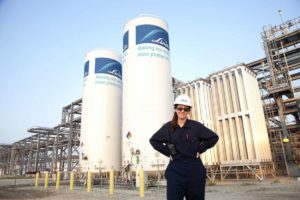 Hydrogen, the world’s most abundant element, has long held the promise of transforming the energy industry because of its almost limitless supplies. But costs of producing hydrogen remain high, and dreams of fuel cell-powered cars and other applications have yet to be realized.
Hydrogen, the world’s most abundant element, has long held the promise of transforming the energy industry because of its almost limitless supplies. But costs of producing hydrogen remain high, and dreams of fuel cell-powered cars and other applications have yet to be realized.
The years of unfulfilled promises were summed up by this saying: “Hydrogen is the fuel of the future, and it always will be.”
That, however, is changing — and rapidly — creating opportunities for Houston to become a center of a global hydrogen industry expected to grow 45 percent to nearly $200 billion in 2030, according to the market analytics company Prescient & Strategic Intelligence. Houston, the capital of the oil and gas industry, already is home to 48 plants that extract hydrogen from natural gas, producing 3.6 metric tons of hydrogen a year or more than one-third of U.S. production, used mostly by refineries and industrial plants.
The region also has one of the most extensive networks of hydrogen pipelines — some 1,600 miles — and storage facilities in the world, according to Brett Perlman, CEO of the Center for Houston’s Future, a local think tank.
Although the potential benefits of hydrogen have been known for decades — former President George W. Bush called hydrogen “freedom fuel” — several factors have slowed the widespread adoption, including cost of production, lack of pipelines to transport and distribute the fuel, and limited commercial markets.
But the global urgency to slow climate change is putting new focus on hydrogen and leading the world’s biggest energy companies to view it as an alternative to oil and gas that is not only cleaner, but also one that would allow them to adapt existing production facilities and distribution networks.
The global demand for hydrogen fuel is expected to grow rapidly over the next decade. Government climate targets, for example, call for the number of hydrogen-powered cars on the road worldwide to increase to 2.5 million by 2030 from about 11,000 in 2018.
Michael Graff, CEO of American Air Liquide Holdings, a producer of industrial gases, said his company predicts hydrogen could account for 20 percent of the world’s energy needs over the next 30 years. The Gulf Coast, meanwhile, is likely to remain the center of U.S. hydrogen production, said Andrew Sarantapoulas, vice president of sales and business management for Linde, industrial gas producer.
“With the concentration of production and distribution assets,” Sarantapoulas said, “it’s unlikely the Gulf Coast will be surpassed as the largest hub.”
Flex fuel
As big companies advance research, develop markets and increase production, costs will decline to put hydrogen on par with other sources of energy, following the same pattern as with the development of solar energy, said Robert Hebner, director of the Center for Electromechanics at the University of Texas at Austin.
“As the volume went up and the cost came down, applications grew and (solar energy) suddenly became competitive,” Hebner said. “We’re seeing those things happen now.”
Hydrogen has several applications — Perlman calls it the “Swiss army knife” of fuels. Among the best known are fuel cells, which tap the chemical energy of hydrogen through a reaction with oxygen to produce electricity, leaving water and heat as byproducts. Fuel cells can power everything from large electric plants to heavy-duty trucks and passenger cars.
Companies with large warehouse operations, including Walmart and Amazon, use fuel cell-powered forklifts, which operate more cleanly and efficiently than those powered by batteries or fossil fuels.
Hydrogen is valued as a zero carbon emissions fuel, but the way it’s produced determines its ultimate carbon footprint.
About 95 percent of the commercial hydrogen, which is derived from natural gas, is called “gray hydrogen,” because its production releases large volumes of carbon dioxide, about 9 parts carbon dioxide to every 1 part of hydrogen.
The hydrogen is classified as “blue” if the carbon dioxide is captured before it is released into the atmosphere and stored, a process that increases production costs by about 40 percent, according to S&P Global Platts.
“Green hydrogen” is produced through a process known as electrolysis, in which electricity generated by wind, solar and other renewable energy sources separates hydrogen atoms from oxygen atoms bonded together in water. The process releases no carbon dioxide but is the most expensive, at least triple the cost of gray hydrogen, according to the International Energy Agency.
The Houston area is well positioned to be a major player in the development of a robust hydrogen energy market in the near future, Perlman said. Energy companies can create a significant market in blue hydrogen within the next two to three years adding carbon capture to gray hydrogen production, he said.
Some end-users already are looking to the Houston area as the source of hydrogen production to fuel their projects. The utility Entergy is developing a project at its Sabine power plant near Port Arthur that would use hydrogen as a fuel to generate electricity.
Initially, the plant could burn up to 30 percent hydrogen, eventually growing to 100 percent as market conditions become more favorable, said Jon Long, Entergy’s vice president of capital projects.
Much of the U.S. market for hydrogen fuel is concentrated in California. The state has adopted low-carbon standards that provide incentives for alternative vehicle fuels, attracting companies such as the European oil major Royal Dutch Shell to develop hydrogen production, distribution and retailing operations there.
Wayne Leighty, Shell’s hydrogen commercial manager for North America, said several factors combine to make the Texas Gulf Coast the ideal region for producing hydrogen: an abundance of energy sources — both renewable and natural gas — as well as a geology that allows for underground storage of hydrogen and captured carbon dioxide.
Startups coming
Nico Bouwkamp, technical program manager of the California energy consulting firm Frontier Energy, said he divides his attention between the California Fuel Cell Partnership, a government-industry collaboration based in West Sacramento, Calif., and a research partnership led by the University of Texas at Austin.
The Texas initiative will develop two hydrogen energy projects. One, located at UT Austin’s J.J. Pickle Research Campus will generate zero-carbon hydrogen through electrolysis, using both solar and wind power, as well as produce hydrogen from methane, the primary component of natural gas, emitted from a landfill.
The UT partnership, funded in part by the Department of Energy’s Hydrogen and Fuel Cell Technologies Office, also will conduct a feasibility study for increasing hydrogen production and use at the Port of Houston.
“The (Energy Department) is interested because on a commercial basis, there’s much more hydrogen activity in Texas than anywhere else in the U.S,” said Brian Weeks, senior director of business development for the Gas Technology Institute, an Illinois research group addressing global energy and environmental challenges.
Houston’s existing hydrogen assets and friendly business climate makes the city attractive to small, entrepreneurial hydrogen-related companies, Perlman said,
One company, Utility Global, a startup that develops hydrogen electrolyzer technology, recently relocated its headquarters, research and development, and manufacturing operations from Utah to Houston. The 10-person company, launched in early 2019, has developed a proprietary electrolyzer to separate hydrogen from oxygen in water, which the company says can be manufactured more cheaply and efficiently than standard electrolyzers.
The company has also developed a process that uses heat, rather than costly electricity, to produce hydrogen from water. The process can emit carbon dioxide, depending on the fuel used to generate heat, which must then be captured and stored, CEO Matt Dawson said.
Dawson said the company relocated to tap into Houston’s talent pool of oil and gas workers, many of whom have skills that are transferable to hydrogen production, distribution and storage.
“We don’t see a path forward that doesn’t rely on that expertise,” Dawson said.
Hydrogen production in Houston has been viewed as part of the oil and gas industry, said Perlman of the Center for Houston’s Future, but it has begun to emerge as a separate industry. As hydrogen’s role in the energy mix grows, Houston is poised to expand its portfolio as the world’s energy capital, Perlman said.
“If you think of hydrogen as an industry, which we’re going to start to think about very soon, then we are one of the largest players not only in the U.S. but also one of the largest global players,” Perlman said.




0 Comments